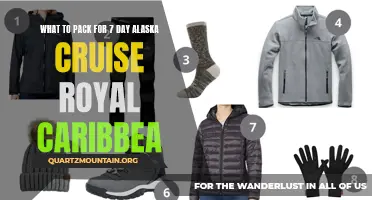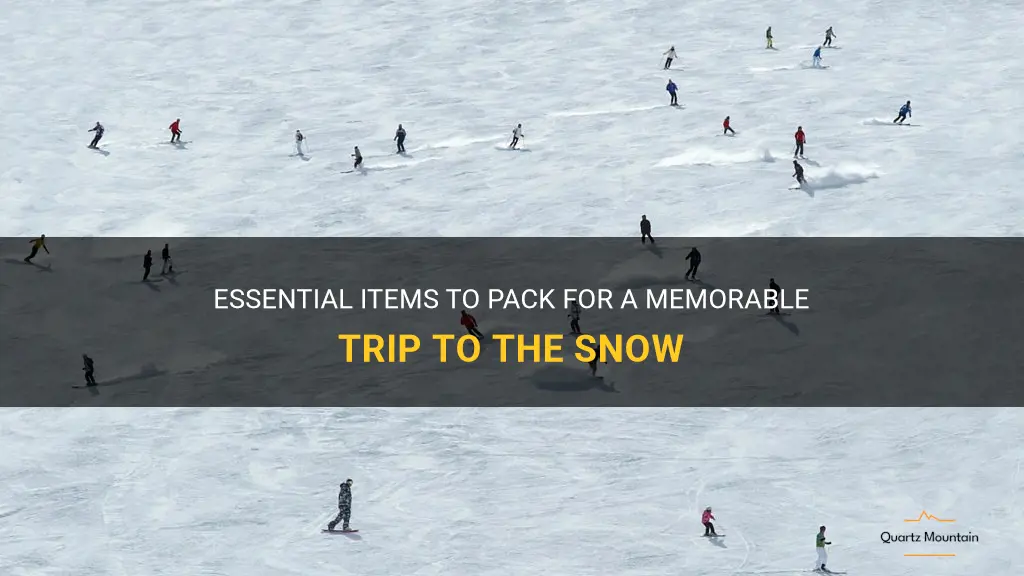
Planning a trip to the snow? From skiing on powdery slopes to cozying up by a roaring fire, a winter getaway promises a memorable experience. However, before you hit the road, it's essential to prepare for the cold climate with the right gear and essentials. In this article, we will delve into the must-have items to pack for a memorable trip to the snow, ensuring you stay warm, comfortable, and well-equipped for all your snowy adventures. So grab your gloves and snow boots, and get ready to make unforgettable memories in a winter wonderland.
What You'll Learn
- What are the essential clothing items to pack for a trip to the snow?
- What type of footwear is best for walking in snowy conditions?
- Are there any specific accessories or gear that are necessary for a snow trip?
- What are some important items to pack for staying warm and comfortable in colder temperatures?
- Are there any specific medical or safety items that should be included in a snow-trip packing list?

What are the essential clothing items to pack for a trip to the snow?
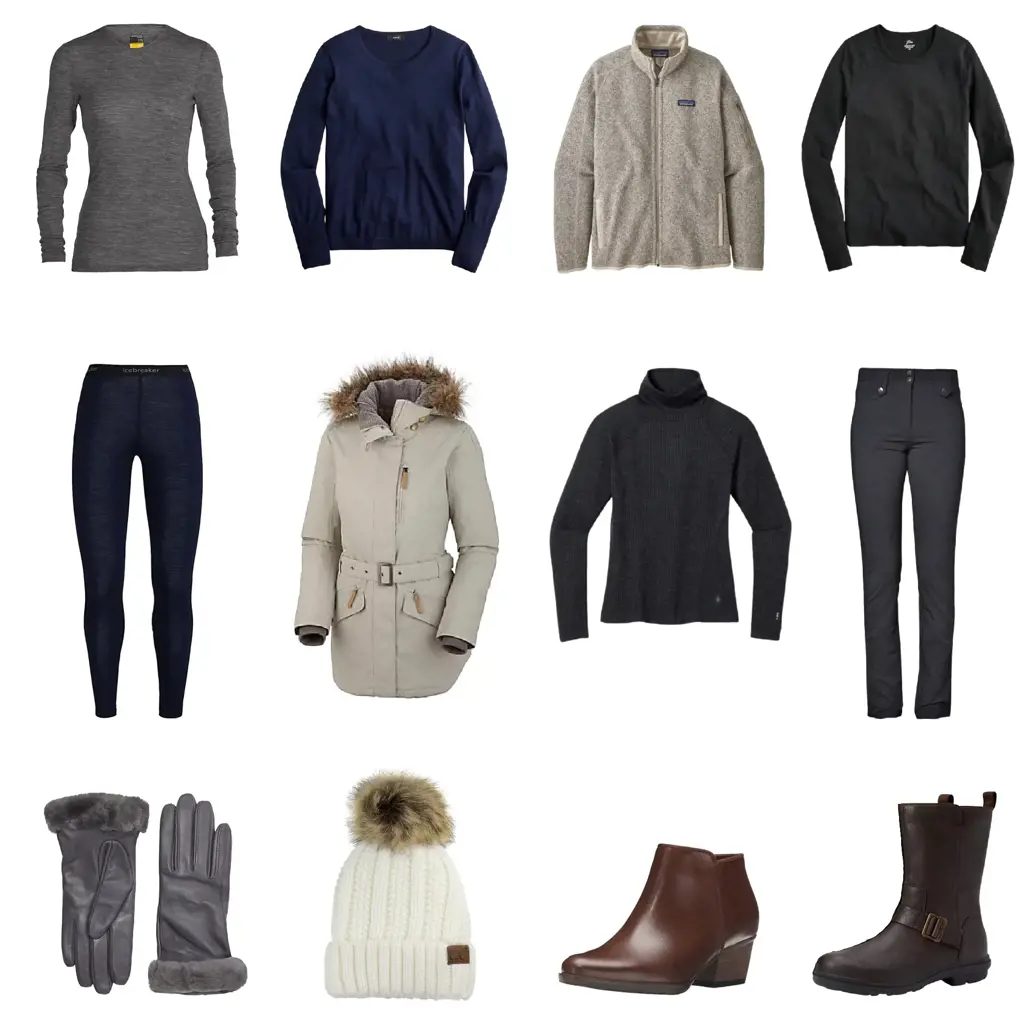
When planning a trip to the snow, it is essential to pack the right clothing items to ensure comfort and protection from the cold temperatures. Whether you plan to ski, snowboard, or simply enjoy the winter scenery, having the appropriate clothing will make your experience much more enjoyable. In this article, we will explore the essential clothing items to pack for a trip to the snow.
- Base Layer: The base layer is the first layer of clothing that goes directly against your skin. It is designed to wick moisture away from your body and keep you dry. Look for base layers made from materials such as merino wool or synthetic blends.
- Mid Layer: The mid layer provides insulation and helps regulate your body temperature. This layer can consist of a fleece jacket, down vest, or synthetic insulated jacket. It should be breathable and moisture-wicking.
- Outer Layer: The outer layer, also known as the shell, is designed to protect you from wind, snow, and rain. Look for a waterproof and breathable jacket and pants. Gore-Tex is a popular material known for its ability to repel water while allowing moisture to escape.
- Snow Pants: A pair of waterproof and insulated snow pants is essential for keeping your legs warm and dry. Look for pants with reinforced knees and seat for added durability.
- Gloves or Mittens: Your hands are often the most exposed to the cold, so having a good pair of gloves or mittens is crucial. Look for insulated and waterproof options to keep your hands warm and protected.
- Hat or Beanie: A hat or beanie is essential for keeping your head warm. Look for options made from a warm, insulating material such as wool or fleece.
- Socks: Invest in a good pair of moisture-wicking and insulated socks to keep your feet warm and dry. Avoid cotton socks as they tend to hold moisture and can lead to cold feet.
- Boots: A pair of waterproof and insulated boots with good traction is necessary for walking through snow and icy conditions. Look for boots that provide ankle support and have a grippy sole.
- Goggles or Sunglasses: Protect your eyes from the glare of the sun and snow with a pair of goggles or sunglasses. Look for options with UV protection and anti-fog coatings.
- Neck Gaiter or Scarf: Keep your neck warm and protected from the cold winds with a neck gaiter or scarf. Look for options made from a soft and insulating material.
Remember to layer your clothing to trap air between the layers for added insulation. This allows you to adjust your clothing according to the temperature and your activity level. It's also important to choose clothing items that fit well and allow for freedom of movement.
In conclusion, when packing for a trip to the snow, make sure to include base layers, mid layers, an outer shell, snow pants, gloves or mittens, a hat or beanie, socks, boots, goggles or sunglasses, and a neck gaiter or scarf. By having the right clothing items, you can stay warm, dry, and comfortable during your snowy adventures.
Essentials to Pack for a 10-Day Adventure in Portugal
You may want to see also

What type of footwear is best for walking in snowy conditions?
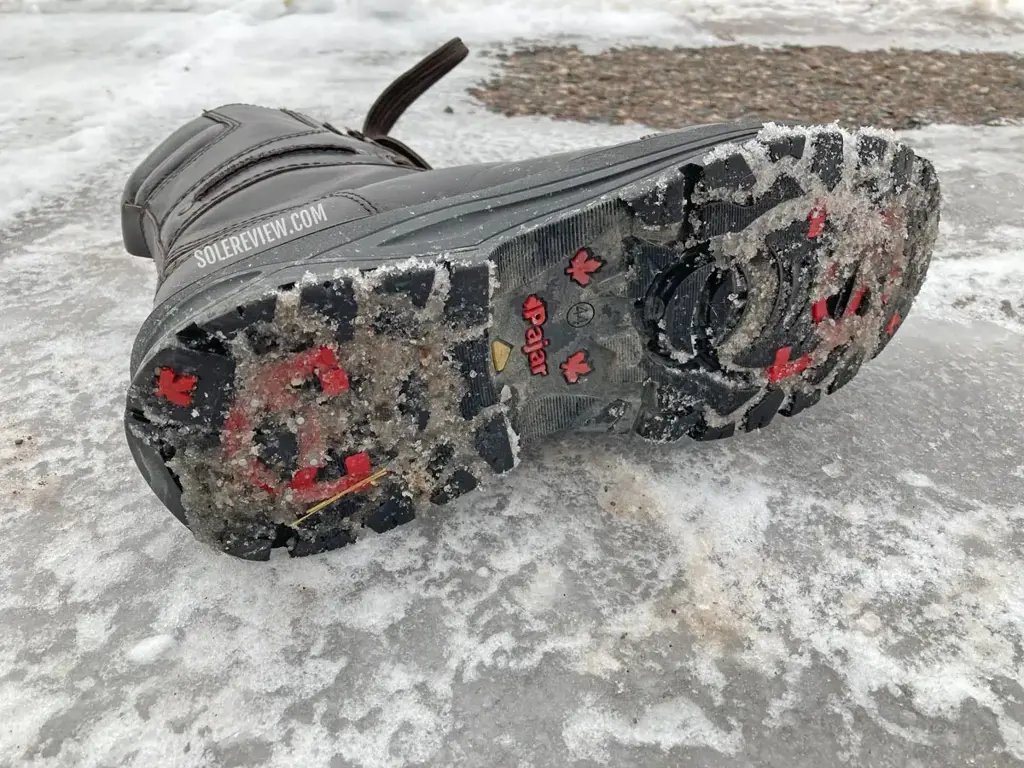
When it comes to walking in snowy conditions, having the right footwear is essential for both safety and comfort. Snowy conditions can be icy and slippery, so it's important to choose shoes that provide sufficient grip and traction. There are several types of footwear that are specially designed for walking in snowy conditions, and each has its own advantages.
One popular option is snow boots. Snow boots are typically made with waterproof materials and have a thick, treaded sole that provides good traction on slippery surfaces. The insulation in snow boots helps to keep your feet warm, and some models even have a fleece lining for added comfort. Snow boots are usually high-cut, which offers additional ankle support and helps to keep snow out of your shoes.
Another option is hiking boots. While hiking boots are not specifically designed for snowy conditions, they are often made with materials that are water-resistant and have a good grip. Hiking boots are generally more durable than snow boots and provide better support for your feet and ankles. It's important to choose a pair of hiking boots with a treaded sole to ensure good traction on snowy and icy surfaces.
If you prefer a more casual look, you can opt for winter sneakers or athletic shoes with a non-slip sole. Winter sneakers are designed with a thicker sole and improved traction to provide better stability on slippery surfaces. However, they may not offer the same level of insulation and waterproofing as snow boots or hiking boots.
When choosing footwear for walking in snowy conditions, it's essential to consider the type of activity you'll be engaging in. If you plan on hiking or walking on uneven terrain, it's best to opt for snow boots or hiking boots, as they provide better support and stability. On the other hand, if you'll be primarily walking on flat surfaces, winter sneakers or athletic shoes may be sufficient.
Regardless of the type of footwear you choose, proper maintenance is important to ensure longevity and effectiveness. It's recommended to regularly clean your shoes after each use to remove salt and dirt that can damage the material. Additionally, you can apply a waterproof spray to further protect your shoes from moisture and snow.
In conclusion, the best type of footwear for walking in snowy conditions depends on your specific needs and preferences. Snow boots, hiking boots, winter sneakers, and athletic shoes all have their own advantages and are designed to provide grip, traction, and insulation. By selecting the appropriate footwear and properly maintaining them, you can ensure a safe and comfortable walking experience even in snowy conditions.

Are there any specific accessories or gear that are necessary for a snow trip?
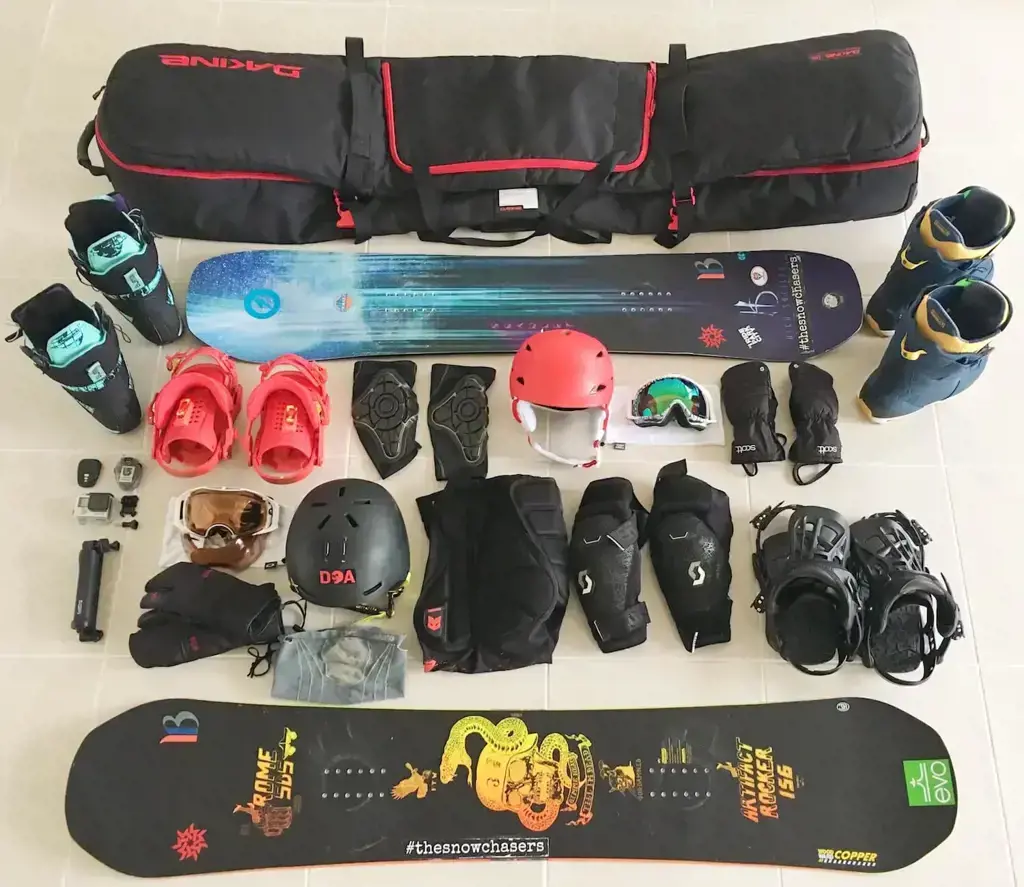
Heading: Essential Accessories and Gear for a Snow Trip
Introduction:
When planning a snow trip, it's important to come prepared with the right accessories and gear to ensure a safe and enjoyable experience. Whether you're a seasoned skier, snowboarder, or just looking to have fun in the snow, having the right equipment can make a world of difference. In this article, we will explore the essential accessories and gear you'll need for a snow trip, including clothing, protective gear, and equipment.
Clothing:
When venturing into the snowy outdoors, it's crucial to dress appropriately to protect yourself from the cold and wet conditions. Start with a good base layer made of moisture-wicking materials, such as merino wool or synthetic fabrics, to keep your body dry and warm. Layer on a mid-layer made of fleece or down for insulation, and finish with a waterproof and windproof outer layer, such as a ski jacket and pants. Don't forget about accessories like gloves, hats, and neck gaiters to protect your extremities from frostbite.
Protective Gear:
Safety should always be a top priority when engaging in snow activities. Wearing a helmet is essential for skiing and snowboarding, as it helps protect against head injuries in case of falls or collisions. Additionally, goggles are crucial for protecting your eyes from glare, blowing snow, and harmful UV rays. It's important to choose goggles with proper ventilation and a fit that accommodates your helmet. Knee and wrist guards are also recommended for those involved in high-impact snow sports to reduce the risk of injury.
Equipment:
The type of equipment you'll need depends on the specific snow activities you plan on participating in. Skiers will require skis, boots, and poles, while snowboarders will need a snowboard and boots. Ensure that your equipment is the correct size and properly fitted to your body and skill level. Safety bindings on skis and snowboards are essential to prevent leg injuries. If you're not familiar with the technical aspects of equipment selection, don't hesitate to consult with a professional at a snow sports shop who can guide you in choosing the right gear.
Other Accessories:
Aside from the essentials mentioned above, there are a few additional accessories that can enhance your snow trip experience. Hand warmers or heated gloves are great for keeping your hands toasty in cold conditions. A backpack with hydration pack compatibility is handy for carrying essentials like water, snacks, and additional clothing layers. Lastly, sunscreen is often overlooked but crucial when spending time in the snow, as the sun's rays can be magnified by the reflection off the snow, increasing the risk of sunburn.
When planning a snow trip, it's essential to invest in the right accessories and gear to ensure both your safety and enjoyment. Dressing appropriately for the cold conditions, wearing protective gear, and using the correct equipment will greatly enhance your experience while minimizing the risk of injury. Additionally, don't forget about other accessories like hand warmers, backpacks, and sunscreen, which can further enhance your snow trip. By being well-prepared, you'll be able to fully enjoy the beauty and excitement of the snowy outdoors.
Essential Items to Pack for Your Trip to Belize
You may want to see also

What are some important items to pack for staying warm and comfortable in colder temperatures?
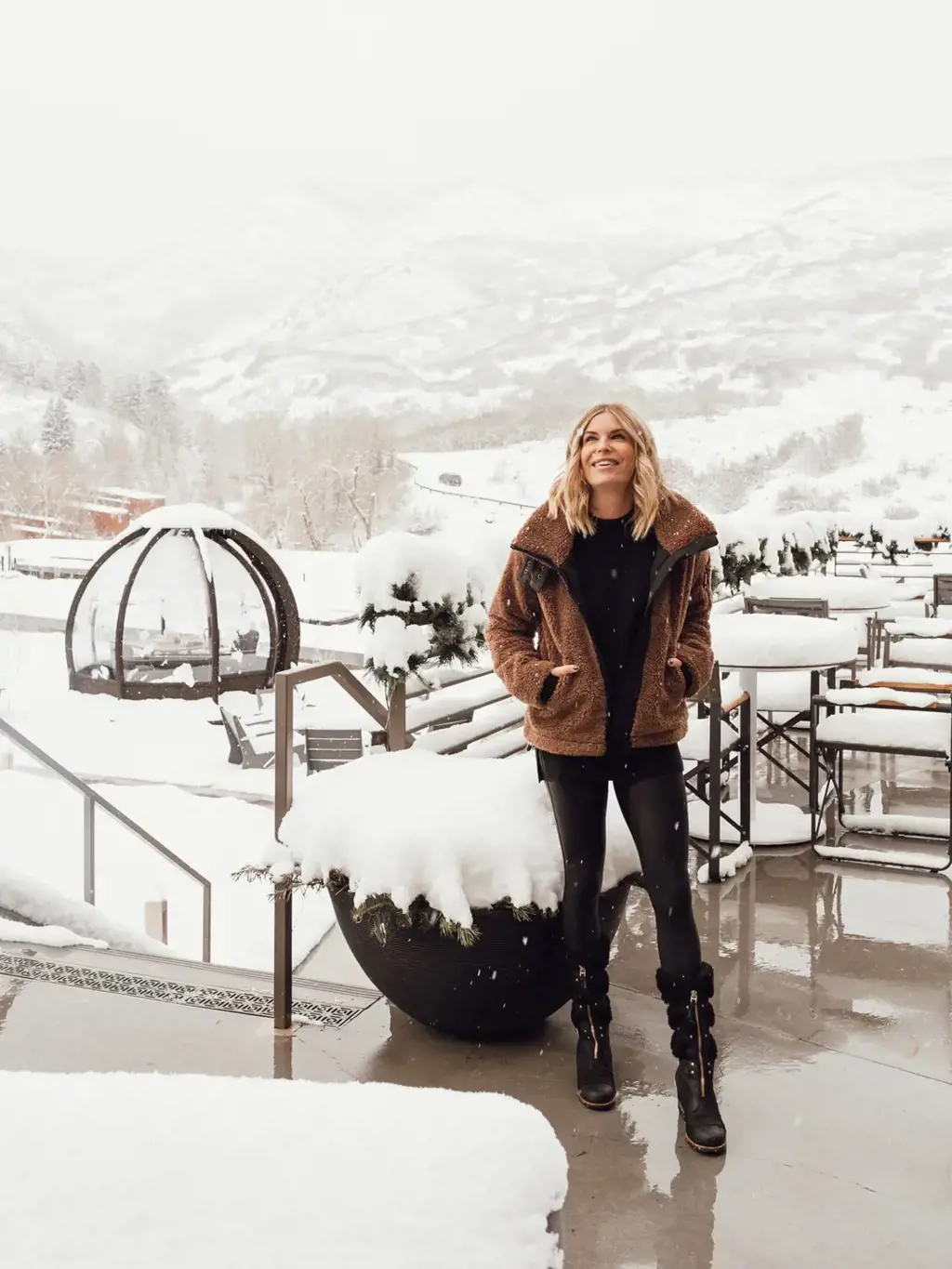
When venturing into colder temperatures, it's crucial to pack the right items to ensure you stay warm and comfortable. Whether you're going skiing, hiking, or simply spending time in a colder climate, here are some important items you don't want to forget.
- Clothing layers: Layering is essential for staying warm in cold weather. Start with a moisture-wicking base layer made of materials like merino wool or synthetic fibers. This layer will help keep you dry by wicking away sweat from your body. Next, add an insulating mid-layer, such as a fleece or down jacket, to trap heat and provide extra warmth. Finally, top it off with a waterproof and windproof outer layer to protect you from the elements.
- Insulated footwear: Cold weather can be harsh on your feet, so investing in a pair of properly insulated boots is crucial. Look for boots with a high-quality insulation material like Thinsulate or Primaloft, which will keep your feet warm even in freezing temperatures. Make sure the boots are waterproof to keep your feet dry in wet or snowy conditions.
- Hats, gloves, and scarves: Heat escapes from our bodies through our heads, hands, and necks, so it's important to cover these areas. Pack a warm hat that covers your ears, insulated gloves or mittens, and a scarf to wrap around your neck.
- Thermal underwear and socks: Thermal underwear and socks made from materials like merino wool or synthetic fibers are excellent investments for staying warm in colder temperatures. These materials provide insulation, wick away moisture, and regulate body temperature. Avoid cotton socks, as they absorb moisture and can make your feet feel cold and uncomfortable.
- Hand and foot warmers: For extra warmth, consider packing hand and foot warmers. These small pouches contain chemicals that generate heat when exposed to air. They can be inserted into your gloves or boots and provide hours of warmth, making them perfect for activities like skiing or hiking in extremely cold temperatures.
- Insulated water bottle: Staying hydrated is important, even in cold weather. Insulated water bottles will help keep your drinks from freezing, ensuring you have access to water throughout the day. Some insulated bottles even come with built-in heaters to warm your beverages in extremely cold conditions.
- Portable seat cushion: If you'll be spending extended periods of time in the cold, such as while watching a sports game or waiting for public transport, a portable seat cushion can make a significant difference in your comfort level. Look for cushions made from insulating materials like foam or those with built-in insulation.
- Heat packs or warm blankets: If you're planning on spending time outdoors in freezing temperatures, consider packing heat packs or warm blankets. Heat packs can be placed inside your pockets or gloves to provide extra warmth, while warm blankets are great for wrapping around yourself during breaks or emergencies.
Remember, it's always better to overpack and have extra items than to be underprepared in colder temperatures. The key is to layer your clothing, invest in quality insulated gear, and prioritize items that will keep your body warm and comfortable. By packing these important items, you'll be able to enjoy your time in colder temperatures without the discomfort of being cold.
Essential Cartoonish Items to Pack for a Memorable Trip to Scotland
You may want to see also

Are there any specific medical or safety items that should be included in a snow-trip packing list?
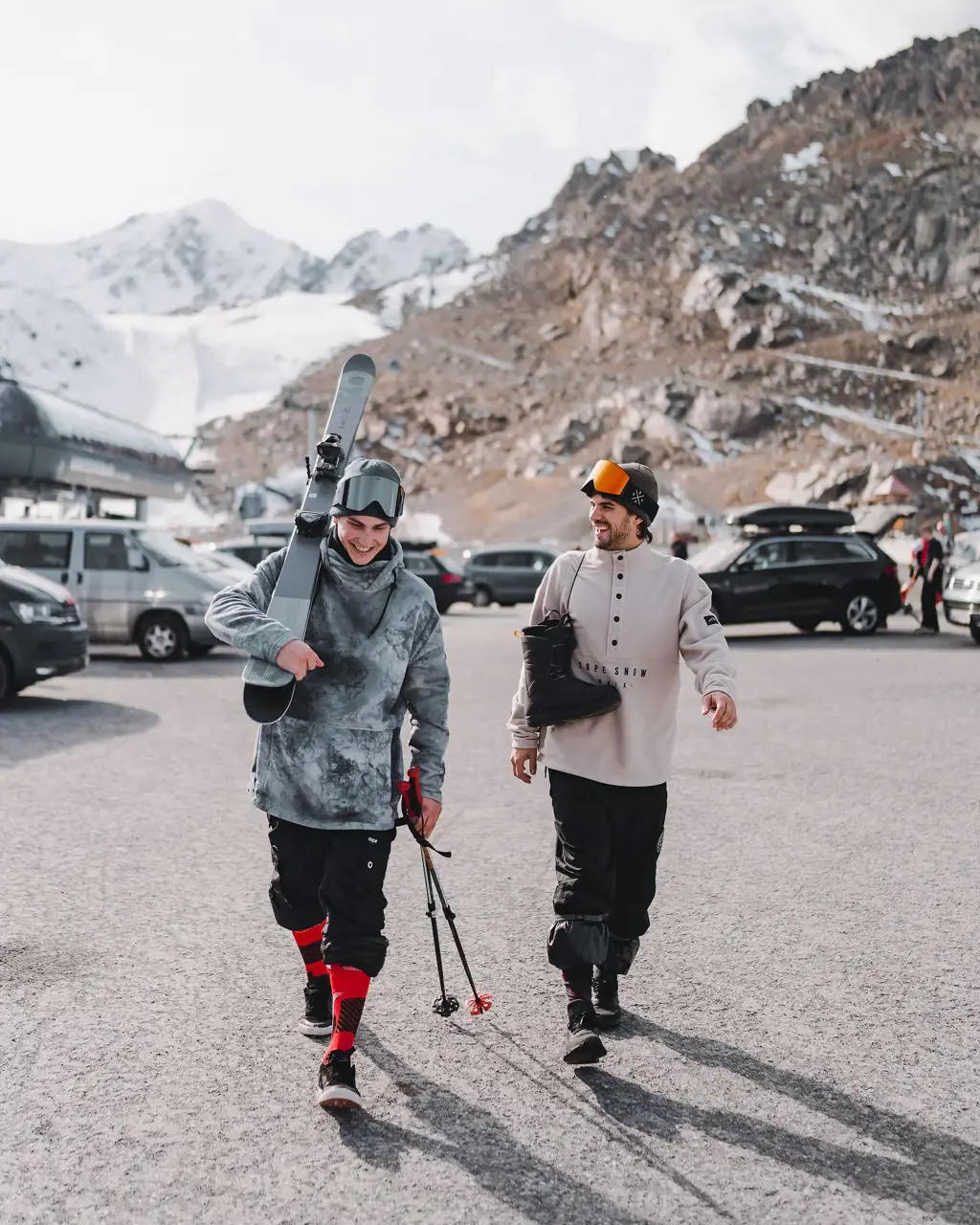
When going on a snow trip, it's important to be prepared for both the fun and the potential risks associated with snowy conditions. In addition to your regular packing list, there are a few specific medical and safety items that you should include to ensure a safe and enjoyable winter adventure. Here are some recommendations:
First Aid Kit:
A well-stocked first aid kit is essential for any outdoor activity, especially in snowy conditions. Make sure your kit includes items such as bandages, gauze, adhesive tape, antiseptic wipes, and pain relievers. You may also consider including items like instant cold packs, tweezers, and scissors.
Prescription Medications:
If you or anyone in your group requires prescription medications, be sure to pack an ample supply for the duration of the trip. It's also a good idea to carry a copy of your prescriptions, just in case.
Hand Warmers:
Cold hands can quickly become uncomfortable, and even dangerous, in snowy conditions. Pack several sets of hand warmers to keep your hands warm and prevent frostbite. These small packets can be easily activated by shaking, and they provide several hours of gentle heat.
Sunscreen and Lip Balm:
Snow reflects sunlight, which can increase your risk of sunburn and chapped lips. Apply a high SPF sunscreen to all exposed areas of skin, and use a lip balm with SPF to protect your lips from the harsh winter elements.
Avalanche Safety Gear:
If you plan on skiing, snowboarding, or engaging in any other backcountry activities, it's essential to have the necessary avalanche safety gear. This typically includes a beacon, shovel, and probe. Ensure that you and your group are trained in how to use this equipment effectively.
Waterproof and Insulated Clothing:
Having the right clothing is crucial for staying warm and dry in the snow. Invest in waterproof and insulated jackets, pants, gloves, and boots. Layering is also important, as it allows you to add or remove clothing as needed to regulate your body temperature.
Emergency Contacts and Communication Devices:
Before embarking on your snow adventure, make sure to have a list of emergency contacts programmed into your cell phone or written down. Additionally, pack a fully charged portable charger to ensure your phone remains operational during emergencies. It's also wise to have a whistle or signaling device in case you need to attract attention.
Avalanche Safety Training:
If you plan on venturing into avalanche-prone areas, it's highly recommended to undergo formal avalanche safety training. This training provides valuable knowledge and skills to help you make informed decisions and avoid dangerous situations.
Navigation Tools:
Carry a map, compass, or GPS device to help you navigate the snowy terrain. Familiarize yourself with the area beforehand and plan your routes accordingly.
Emergency Blanket:
In case of a medical emergency or unexpected overnight stay, having an emergency blanket can provide essential warmth and insulation. These lightweight and compact blankets retain body heat and can be a lifesaver in extreme situations.
Remember, being prepared is key to a safe and enjoyable snow trip. Pack these essential medical and safety items, and always prioritize your well-being while out in the winter wilderness. Enjoy your snowy adventure responsibly!
The Ultimate Guide to Packing for Your Tulum Getaway: Must-Have Outfits and Essentials
You may want to see also
Frequently asked questions
When packing for a trip to the snow, it is important to bring warm clothing that will protect you from the cold temperatures. This includes items such as thermal base layers, a thick winter coat, insulated pants, warm socks, and waterproof boots. Don't forget to pack hats, gloves, scarves, and earmuffs to keep your extremities warm. It is also advisable to bring multiple layers of clothing, so you can adjust your outfit according to the weather conditions.
Yes, you will need some specific equipment for a trip to the snow. The most important item is a good pair of snow boots with a strong grip to prevent slipping on icy surfaces. You will also need a pair of snow pants to keep your legs dry and insulated. Additionally, it is recommended to bring a ski or snowboard jacket if you plan on participating in winter sports. Other useful equipment includes goggles to protect your eyes from glare and snowfall, and a helmet if you plan on skiing or snowboarding.
Besides warm clothing and equipment, there are a few other essentials you should pack for a trip to the snow. Don't forget to bring sunscreen with a high SPF, as the sun's reflection off the snow can be intense and lead to sunburns. Lip balm with SPF is also important to prevent chapped lips. It is also a good idea to bring a small first aid kit with supplies like band-aids, pain relievers, and antiseptic ointment in case of any minor injuries. Lastly, pack some snacks and water bottles to keep yourself hydrated and energized throughout the day.



